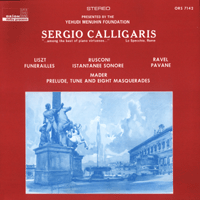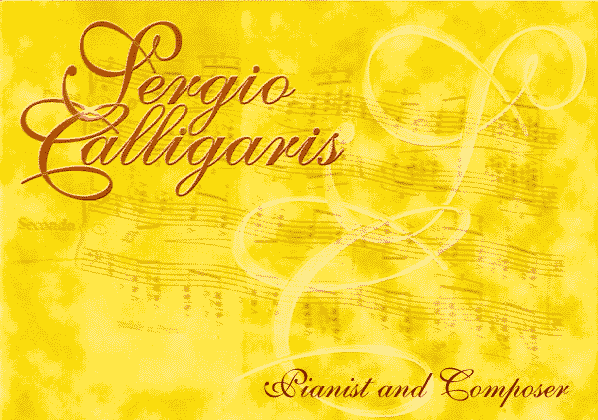 SERGIO CALLIGARIS
SERGIO CALLIGARIS
Recital
[LP: Orion Records, stereo ORS 7142]
SIDE 1
Franz Liszt:
Funerailles (12'22")
Maurice Ravel:
Pavane pour une infante défunte (5'54")
SIDE 2
Gerardo Rusconi:
Istantanee sonore (3'48")
Clarence Mader:
Prelude, tune and eight masquerades (15'26")
There are souls who are invincibly drawn, by virtue of their solitude and meditation,
toward infinite thoughts, that is to say, to religion. Their entire conscience is absorbed
in prayer, their existence a mute hymn to divinity and expectation. They search in
themselves and in creation about them a stairway to God, images and expression by which to
reveal themselves to Him, so He may be revealed to them; could I but aid them! There are
hearts broken by pain, rejected by all, that seek refuge in a world of their thoughts, in
the solitude of their souls, to weep, to await, to worship. May they be visited by a Muse
as solitary as themselves, find sympathy in it, and say: we pray with your words, weep
with your tears, call forth with your songs!
[Alphonse Lamartine (1790-1869): Foreword to "Harmonies poétiques et
religieuses"]
Funérailles, the seventh work in Harmonies, was considered by some to be
a funeral ode for Chopin. Although written in October, 1849 (Chopin died October 17th), it
was actually composed in memory of a trio of Liszt's friends, Prince Lichnowsky and Counts
Batthany and Teleki, all killed in the 1848 Hungarian uprising. The dedication is to the
Countess Carolyne Sayn-Wittgenstein (Liszt was her lover). Funérailles is a
somber, introspective work, grandiose and fittingly stately. There is the inevitable
impassioned climax in the middle of the piece, and a tender, almost other-worldly return
of the main theme towards the end, an evocation of the spirit, devoid of flesh.
Pavane pour une infante défunte (Pavane for a Dead Princess) was the first of
Ravel's works to achieve popular succes. Composed in 1899 and dedicated to the Princess de
Polignac, it was first performed in 1902 by Ricardo Vines, a former classmate of Ravel's
at the Conservatoire. Ravel felt the piece's popularity was out ot proportion to
its musical worth, and claimed it showed the influence of Chabrier. He nevertheless
orchestrated it (in 1910) - which led to even greater popularity of the work. In time,
Ravel grew tired of hearing the Pavane performed with such regularity, and not
always on the highest level of interpretation, and is reputed to have told a group of
young pianists: "What I wrote is a Pavane for a Dead Princess, not a Dead Pavane for
a Princess". The work is a masterpiece in miniature, with its haunting melody and
gentle, dignified dance rhythm.
Gerardo Rusconi is one of the leading composers of the modern Italian school. His music
has often been performed in leading musical centers of Europe. Most recently his Cantata "Per
i semi non macinati" had a highly acclaimed performance by the RAI Chorus and
Orchestra of Turin conducted by Piero Bellugi, while his "Moments for
Orchestra" was performed in Copenhagen at Tivoli Concertsallen conducted by
Heckert-Hansen. His Concertino for Piano and Orchestra was given a new performance
at the famous Pomeriggi Musicali of Milan in January 1971. Mr. Calligaris gave the USA
premiere of Istantanee Sonore on December 9, 1970 in a recital at Schoenberg Hall,
at the University of California at Los Angeles. This composition consists of six episodes
in which Rusconi's extraordinarily clear and definite musical syntax creates these pieces
wherein every accent, rhythmic pattern or melodic line corresponds to a most concentrated
musical expression.
Broken rhythms, enhanced by accents placed with great originality gives the first episode (Allegretto
con accenti) a remarkably interesting articulation. The following (Moderato) is
an alternation of insinuated lyrical lines interrupted by restless developments of
rhythms. The third (Allegro) is a fast figuration alternating between the two hands
in a transparent texture, followed by a Lento Cantabile of a quiet and lyrical
mood. The next piece in contrast (Ritmico-Drammatico ed ostinato) is a tense
episode based on sharp accents. The last (Commiato) consists of a sequence of
mysterious chords moving slowly toward a quiet conclusion in pianissimo.
Clarence Mader's musical career began at the age of eleven, when he became organist of
an Easton, Pennsylvania church where his father was pastor. When he was sixteen, his
family moved to California, where he studied piano with Homer Grunn, and theory with P.
Shaul Hallett. These studies were continued in New York, where he came under the influence
of America's greatest organist, Lynwood Farnam. This led to a life-long interest in the
organ, resulting in upwards of fifty compositions for that instrument, including a
Concerto for Organ Solo and a more recent Concerto for Organ and Orchestra. He was
organist at Immanuel Presbyterian Church in Los Angeles for thirty seven years and a
member of the music faculty at Occidental College. In addition, Clarence Mader enjoyed a
long and illustrious career as a concert organist, giving many recitals across the nation.
He acted as consultant in numerious installations and rebuilding of organs on the West
Coast and in Southern California. He is also chairman of a national committee for the
standardization of organ consoles, this made up of organists and members of various organ
building firms. Mr. Mader contributes to various periodicals, and his works are widely
performed at home and abroad. Besides an opera, choral works and chamber music, there are
piano works and songs.
Prelude, Tune and eight Masquerades was composed in 1943 on a commission from
the Los Angeles Pianist, Berenice Morrison. The Tune, which follows the serious minded
Prelude, is an authentic "Loggers' Song" as heard in the Canadian wilds. (The
words were too robust for printing here). The term Masquerade is appropriate
because the tune is drawn through a series of styles as well as developments. The first
masquerade (which follows the tune) is marked without elegance. Then, following in
order, are: the mystery of the woods; relaxed and wayward; in waggish mood; the sound
of the axe; no more than wind in the trees; the forest comes to life; and finally, hearty
and carefree.
The prelude opens with very simple polyphonic writing, and develops into two big climaxes
in fortissimo. Following the second climax, it concludes in the same simple vein in which
it opened (with the last three notes of the main subject). The theme is exposed, supported
by subtle harmonization. The following masquerades (they are actually variations) present
the theme in a vast metamorphosis of moods, from mysterious (No.1 and 2) to elegant
(No.3), ironic (No.4), majestic (No.5), poetic (No.6), stirring and brilliant (No.7) and
concluding with a spirited fugue.
1971 ORION RECORDS

